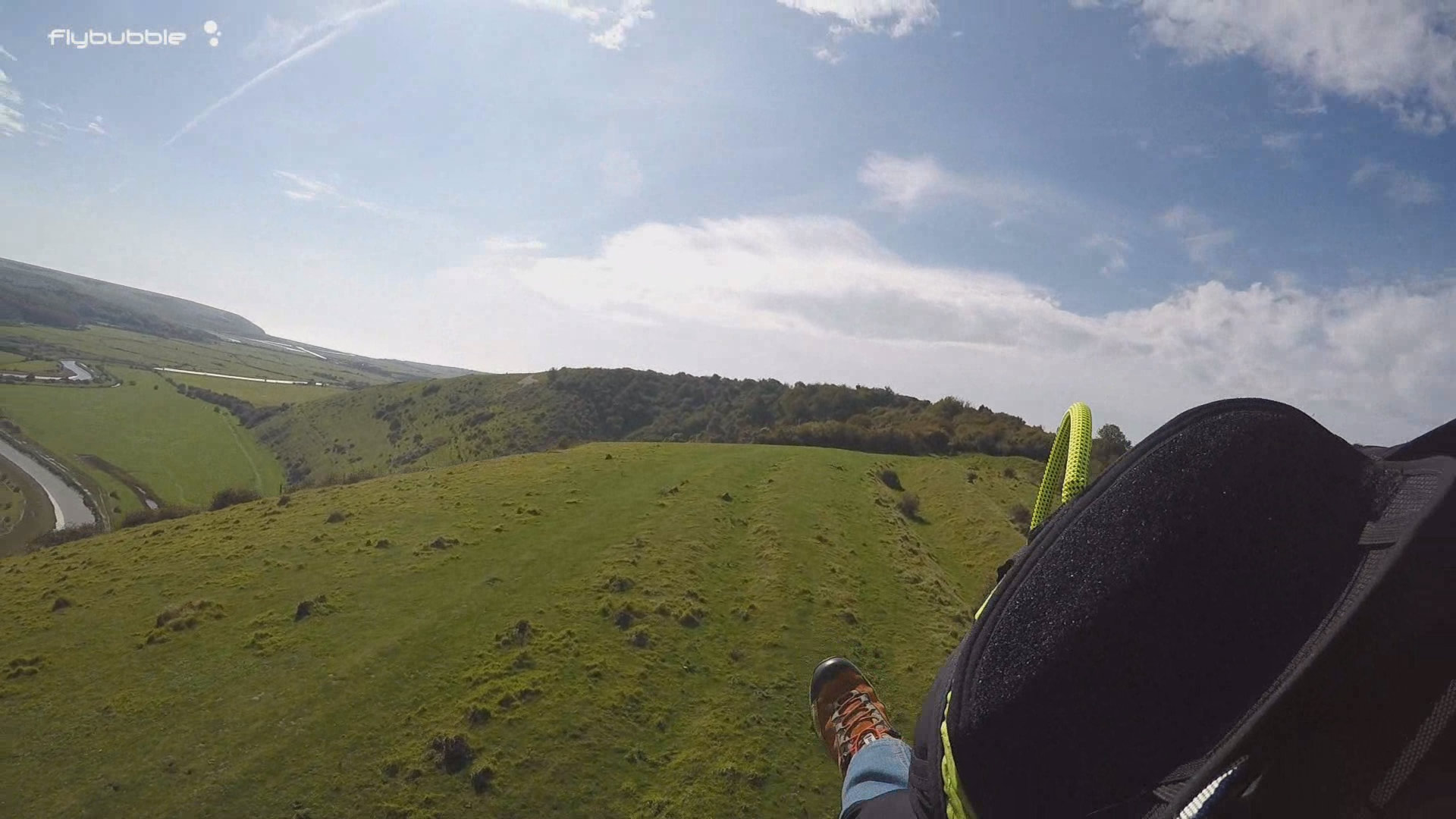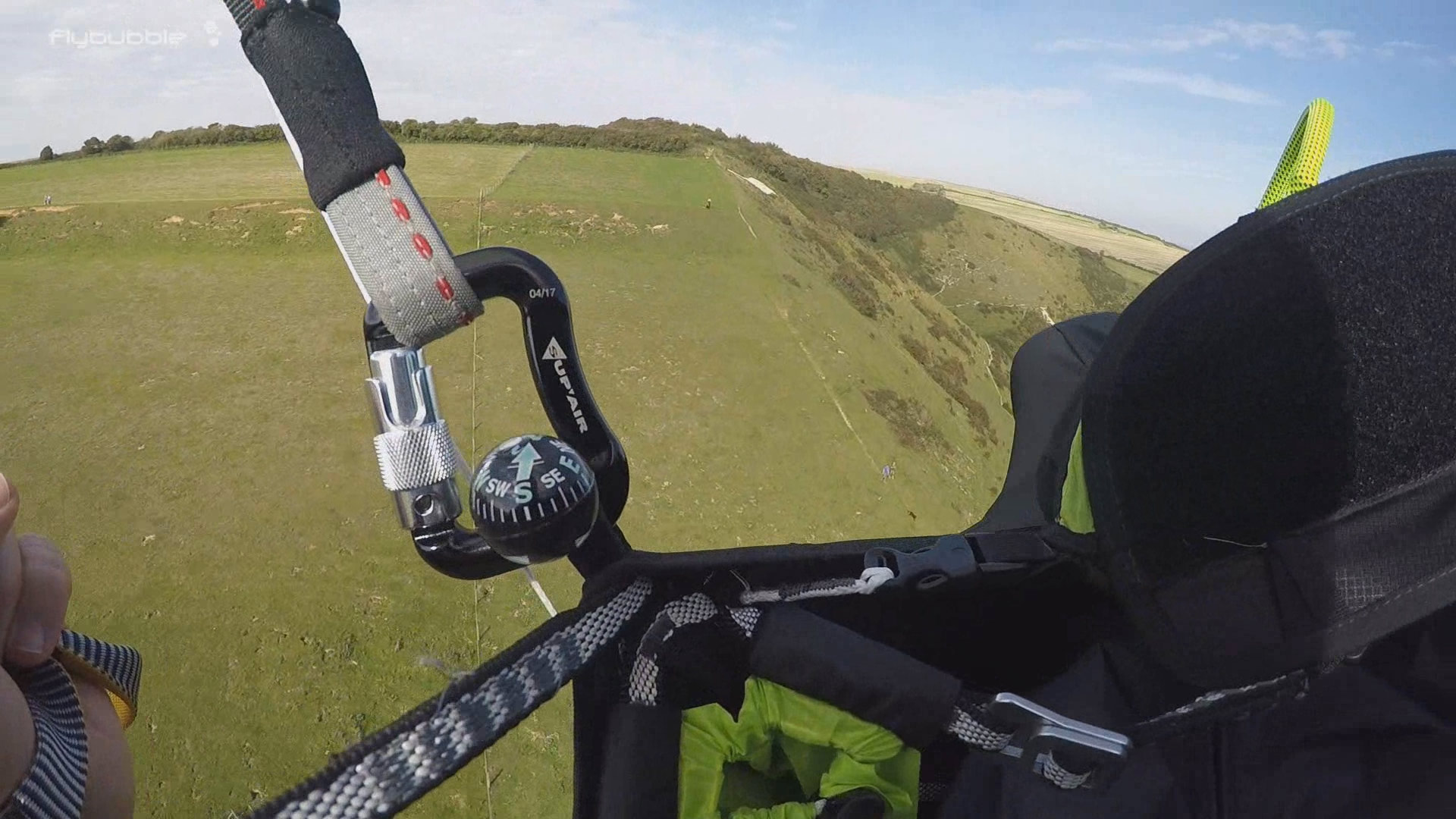
Landing on top of a ridge or even on the launch site is a useful skill for paraglider pilots, but the top of the ridge is usually the windiest place to land. This is partly because of wind gradient (wind often increases with altitude) and partly because of the Venturi effect: the wind is accelerated over the top and around the sides of any obstacle. In this article we study various approaches to making a safe landing.
On the hill in the video (High & Over, which is a ridge of about 100m high, close to sea level), I would expect to have 10km/h extra on the basewind in the region from the fence line through to road at the back. Where the airflow can expand again (at the back of the ridge) the wind has got a bit more space so it diverges and the air is slowed down. But in the region near the crest (probably up to 50m above the hill) it is going to come whipping through. So if the basewind is 30km/h+ you really don't want to have a glider up just on the crest of the hill.
Before toplanding, consider the hazards around the site. At High & Over, the road at the back is a big one, if I start getting dragged by the glider, I know I've got to kill it before the bushes, before I've got any risk of getting into the road. I've got to avoid being lifted up and finding the wind is too strong, because there is really not a lot of room there. So I'd recommend allowing someone with more experience to fly first, to assess the wind strength.
Toplanding approach #1

The wind is quite strong. I don't want to go too far back because I'll be caught in the Venturi. There's lots of lift in the front which makes it difficult to come in from high, so my best approach is to come in low from the other side.
I approach from slightly below takeoff, flying across the slope, allowing the wind to push me back. I get my legs down early, stay pointing slightly into wind, keeping my hands level. I touch down but am lifted again by the wind, so just wait to touch down again.
Keeping the wing to the side of you (uphill) means that it won't pull you as hard. If you let it drop back directly downwind of you, it could pull you off your feet and begin the drag towards the dreaded road.
Toplanding approach #2

I put myself a bit deeper this time (slightly further back on top of the ridge line). I don't want to go too far back, but I'm staying out of the lift. I have a strong (hard) landing because I'm just behind the crest and I'm in the sinking air. If that was a rocky area it wouldn't have been a nice landing at all.
If I'm approaching a toplanding with sharp uneven terrain, I find a spot where the wind is stronger (so my groundspeed is reduced) and I try to land closer to the front of the ridge (so I don't get pounded into the ground). This can be challenging.
Toplanding approach #3

In this instance I choose a much easier area with a lot more space to topland. This would be a better choice (if you had alternatives). It's easy to be tempted to go to the downwind edge of such a large space, but you don't want to go too far to the back where the Venturi will accelerate the wind at the point where the airflow is about to fall down the back slope.
In this scenario there's also a risk of turbulence from the front ridge, where there's a little step or sharp edge. So to topland here I just want to find a place where I am out of the lift, but not too far back. When I find that spot I come down onto quarter brakes (pointing mostly into wind) and just park and let myself slowly descend, hovering in a dead spot.
As I descend I let it drift me slightly back because I've checked the wind speed and it's not too bad, so I know I can afford to go a little bit deeper. I drift myself to the back of the field then shift across the slope towards my landing spot while I'm keeping my glider pointed mainly into wind.
I always get my legs down nice and early so there's one less thing to think about, and I'm in a better position for any nasty surprises.
As I cross the slope I keep it nice and steady and avoid the temptation to pull my brake hand on the slope-side, a common mistake that results in you getting an extra little turn at the end. I just keep my hands level and steady and wait for the slope to intersect my glide path.
Toplanding #4

This setup starts with a downwind approach for demonstration purposes. You really don't want to approach your toplanding downwind because your groundspeed is very high, you rather want to turn out to the side, and come in again on a ridge soaring pass.
I position myself quite far back to avoid the lift, then use about 1/3 brakes to hold myself in the sinky area. In smooth airflow it's safe to use deep brakes, but as you approach the ground and encounter turbulence you must be aware to avoid your stall point.
Toplanding #5

Toplanding well is all about setup. I'm making sure I'm losing my altitude before I'm right in the launch zone. Coming across on a nice line, I drop my legs down fairly early just in case I hit turbulence. As I'm fairly low I am on about 1/4 brakes to keep things slow, getting a nice steady angle across allows you to refine it with small inputs to bring yourself closer to the front of the ridge. Choosing my touchdown point I keep my wing on the upslope side again, so that when I drop it down it doesn't pull so much.
Toplanding #6

The final toplanding shows how to adapt the technique as conditions change: there's quite a lot of lift so I'm coming in fairly low, drifting over the crest at an angle to the wind, I let myself drift back while I'm still reasonably high so I can turn myself more into wind somewhere safe. I encounter some lumpy air which I don't like, at this point, due to my setup, I've still got an option to bail out (and fly forwards). When I do that I get some lift which I can drift back with by holding the brakes on (perhaps 1/3 brake). As the wind is strong I switch to rear risers to kill the wing effectively. As I touch down I pull the back risers pulled, run around the wing to stop the wind grabbing it, then run to the upwind tip and press down on it to disabled the wing. Job done!
